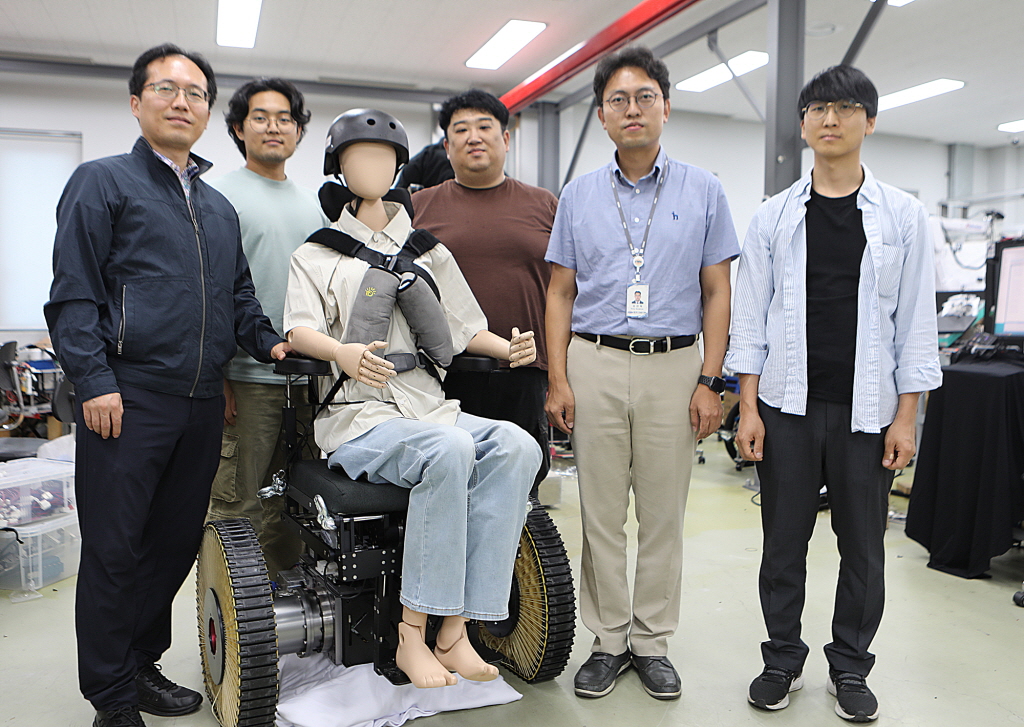과학기술정보통신부 산하 한국기계연구원(원장 류석현)이 액체 방울의 표면장력 원리를 모사해 강성이 자유자재로 변하는 모핑 휠을 세계 최초로 개발하고, 이를 실제 이동체에 적용하는 데 성공했다. 바퀴의 강성을 실시간으로 변화시켜 계단이나 바위같이 일상생활의 다양한 장애물을 극복할 수 있어 도로 위 장애물 극복이 중요한 휠을 활용하는 모든 이동체에 폭넓게 적용될 수 있을 것으로 보인다.

▲한국기계연구원 AI로봇연구소 첨단로봇연구센터 연구팀
기계연, 바위 넘고 계단 오르는 바퀴 세계 최초 개발
액체방울 표면장력 원리 활용 휠 단단함 실시간 변화
바퀴의 강성을 실시간으로 변화시켜 계단이나 바위같이 일상생활의 다양한 장애물을 극복할 수 있는 휠과 이동체 로봇 기술이 세계 최초로 개발됐다. 도로 위 장애물 극복이 중요한 휠을 활용하는 모든 이동체에 폭넓게 적용될 수 있을 것으로 보인다.
과학기술정보통신부 산하 한국기계연구원(원장 류석현)은 액체 방울의 표면장력 원리를 모사해 강성이 자유자재로 변하는 모핑 휠을 세계 최초로 개발하고, 이를 실제 이동체에 적용하는 데 성공했다고 2일 밝혔다.
기계연 AI로봇연구소(소장 박찬훈) 첨단로봇연구센터 송성혁 책임연구원, 박동일 첨단로봇연구센터장 팀이 개발한 모핑 휠은 복잡한 기계 장치나 센서 없이도 스마트 체인 블록에 적용되는 표면장력만 변경시켜 강성을 쉽게 바꿀 수 있는 바퀴 및 모듈화 시스템이다. 일반 주행 시에는 단단한 원형의 바퀴로 작동하다가 장애물을 넘을 때는 바퀴가 말랑해져서 장애물의 높낮이나 모양에 따라 휠을 자유롭게 변형시킬 수 있다.
비공기압 타이어처럼 휠 내부를 유연 구조체로 구성하는 기술은 기존에도 있었다. 기존 기술은 평지 주행 시에도 휠에 지속적인 큰 변형이 발생하여 주행 효율과 안정성이 낮아지고 소음도 커지는 한계가 있다.
반면에 기계연 연구팀이 개발한 휠은 강성을 원하는 대로 조절할 수 있어 고속의 평지 주행 시에는 일반적인 휠과 동일한 강성을 유지하다가 장애물이 있는 경우에만 실시간으로 휠을 말랑하게 바꿔 장애물을 극복할 수 있다는 것이 가장 큰 차이점이다.
기계연 연구팀이 개발한 모핑 휠은 스마트 체인 블록과 유연 구조체로 구성돼 있다. 휠의 최외곽은 스마트 체인 블록으로 구성되며, 스마트 체인 블록의 표면장력을 제어하는 와이어 스포크(wire spoke) 구조가 휠의 허브 구조와 연결되어 있다. 허브 구조가 회전하거나 거리가 변하게 되면, 이와 연결된 와이어 스포크 구조가 강하게 당겨지거나 느슨하게 바뀌면서 스마트 체인 블록 구조의 표면장력이 변화하게 된다.
와이어 스포크를 이용해 블록들을 안쪽으로 강하게 당기는 경우, 휠 최외곽의 스마트 체인 구조끼리 가까워지는 방향으로 힘이 증가하게 된다. 이 과정에서 마치 액체 방울에서 높은 표면장력을 가지는 경우 최외곽 분자 간 인력이 큰 것과 같은 효과가 발생하며 안정적인 원형을 유지하게 된다. 반대로 와이어 스포크 구조가 느슨해지는 경우 낮은 강성으로 변화한다.
연구팀은 지난해 10월 이러한 가변강성 휠의 변화 메커니즘에 대한 검증을 완료했으며, 최근 다양한 이동체에 손쉽게 적용할 수 있는 모듈화 기술을 개발했다. 강성을 변화시키는 메커니즘을 소형화, 경량화하여 휠 내부 공간에 삽입하고, 이를 모듈화하여 투휠 휠체어 등 다양한 이동체 시스템에 적용시켰다.
투휠 기반 휠체어 시스템은 실시간으로 휠의 강성을 가변하여 안정적인 이동이 가능할 뿐 아니라, 제자리 방향 전환 등 좁은 공간에서의 이동에 유리하다. 바위나 18cm 높이의 계단을 극복할 수 있다. 또한 4륜 기반 이동체에도 적용하여 장애물 극복 성능을 시험한 결과, 휠 반경의 1.3배 높이의 장애물까지 안정적으로 극복할 수 있는 것을 확인했다.
송성혁 책임연구원은 “장애물을 극복하기 위한 4족 및 2족 보행 로봇들의 경우 평지에서의 이동 효율이 낮고, 이동 시에도 필연적으로 흔들림이 발생한다는 문제가 있었다”며 “이번에 개발한 모핑 휠은 기존 휠의 장점인 높은 이동 효율은 유지하면서 휠의 한계점이었던 장애물 극복까지 구현 가능하다는 점에서 의의가 있다”고 설명했다.
기계연 첨단로봇연구센터 박동일 센터장은 “표면장력 모사 휠 기술은 기존 장애물 극복을 위한 족형 로봇 및 휠 클러스터 등 복잡한 기계 장치들의 한계를 극복할 수 있는 기술”이라며 “향후 장애물 극복이 가능한 휠체어 및 다양한 이동 로봇, 탑승형 운송 수단 등 광범위하게 활용할 것으로 기대된다”고 말했다.
한편 이번 연구는 ‘사이언스(Science)’의 자매지이며 로봇 분야 1위 저널인 ‘사이언스 로보틱스(Science Robotics)’ 8월호의 표지논문으로 게재됐으며, 기계연 기본사업 ‘하지 장애인의 독립생활 지원 로봇(과제책임자 박동일 센터장)’ 과제의 지원을 받아 수행됐다.
